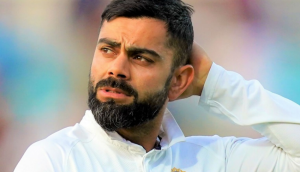Jugraj Singh: the hockey star who would battle terrorists

The player
- Jugraj Singh burst on to the scene in 2000, at the age of 17
- Mastery of the drag flick earned comparison with Sohail Abbas
- His finest moment came in a 2003 match against Pakistan
- He scored two goals and set up two more in a 7-4 win
The cop
- A car accident in 2003 cut short Jugraj\'s career
- He joined the Punjab Police and is now a DSP in Amritsar
- He was one of the first officers to respond to the Gurdaspur attack
- Jugraj reportedly shot and killed one of the attackers
Former Indian cricketers never seem too far from the news. Often not even for cricket-related reasons. The same can't be said for our former hockey players.
Heck, our current hockey team even has an ad that literally begs for India's attention. So, naturally former hockey players stand little chance. And this past week, we realised exactly what it takes for a former hockey player to make the news - a gunbattle with terrorists.
This is the story of Jugraj Singh, once Indian hockey's golden boy, who was part of the police team that battled terrorists recently in Gurdaspur, Punjab.
As Deputy Superintendent of Police in Amritsar, Jugraj was one of the first on the scene. According to some reports he even shot and killed one of the infiltrators, even though Jugraj himself isn't willing to comment on the details.
While the nation now sings paeans about his heroism, Jugraj's is a story that could have been vastly different.
Born to play
Born to a family of hockey players, Jugraj had some big shoes to fill. His sister, Rajbir Kaur Rai, is an Arjuna awardee and was formerly captain of the Indian women's hockey team. His brother-in-law, Gurmail Singh, was part of the 1980 gold medal winning Indian hockey team.
If there was pressure on Jugraj, though, it never showed, because he was born to play hockey.
Pacey, skilful and determined, Jugraj's talents were honed at the famous Surjit Singh Hockey Academy and later the Air India Hockey Academy. At the age of 17, his talent earned him a call-up to the Indian team for the Asia Cup in 2000.
In 2003, against Pakistan, Jugraj was taken off to recover from hits to his legs. He returned to help India win
His performance as the team's go-to drag flicker and a tough-as-nails left back helped India clinch gold. This was the start of Jugraj's meteoric rise to Indian hockey's upper echelons.
Drag flicking at the time was a skill in great demand. The unlimited substitutions rule meant teams had specialised drag flickers who'd come on just for penalty corners. India, having never produced a prolific drag flicker, was in danger of being left behind by other teams. That is, of course, until Jugraj.
Master of his craft
His mastery of the drag flick, a technique that was self-taught, catapulted him into the Indian senior team. His lightning quick drag flicks flying past keepers and into the back of the net became a sight Indian fans became accustomed to. With Jugraj lurking at the edge of the box, penalty corners became a lethal weapon for India.
So effective was Jugraj that experts and fans quickly drew comparisons with Pakistani legend, and arguably the greatest drag flicker ever, Sohail Abbas.
Abbas himself acknowledged it, saying he saw a younger version of himself in Jugraj. Lofty praise, yes, but hardly surprising because Abbas had firsthand experience of Jugraj's ability.
Probably Jugraj's greatest ever performance in Indian colours came at the expense of Abbas. It was the 2003 Champions Trophy league match between India and Pakistan. The Pakistani team had raced in to a 2-0 lead by the 20th minute. India needed a miracle. It came in the form of Jugraj.
Two goals in 15 minutes courtesy of his drag flicks helped India claw their way back into the match. He helped set up two more goals. India, having come from behind, eventually won 7-4.
It wasn't just his goal-scoring prowess that helped India win. Abbas' feared drag flick, a weapon that Pakistan used at will, was completely and utterly neutralised by Jugraj.
He fearlessly threw himself in the way of Abbas' shots, demoralising the Pakistani legend. Jugraj blocked Abbas from three penalty corners in the second half, twice taking shots to the legs. He had even to be taken off the field to recover. Still, he came back on to ensure India won.
As DSP in Amritsar, Jugraj was one of the first on the scene. He reportedly even shot and killed one attacker
So brave and crazy were Jugraj's methods that Tahir Zaman, Pakistan's coach, called his tactics "suicide tactics". Jugraj though was nonchalant about his actions. It was an attitude Jugraj displayed every time he donned the Indian jersey. It was this sort of attitude that had hockey experts pegging him for greatness. Less than a month later though, it all changed.
Stopped in his tracks
Jugraj, who was only 20 at the time, was seriously injured in a car accident. He hit a light pole after swerving to avoid hitting a rickshaw puller. He suffered fractures to his pelvis, thigh and elbow. Jugraj battled hard to recover but to no avail. The elbow damage he suffered had taken away his most lethal weapon - the drag flick.
He would never play for the national team again.
Jugraj eventually became a coach with the Indian team, helping nurture India's penalty corner specialists like Sandeep Singh and V.R. Raghunath. Nowadays, he's busy serving the country as part of the Punjab police force.
His bravery in the recent Gurdaspur attack though should come as no surprise. When asked about whether Abbas' sheer power scared him, he replied, "Why fear when we are playing for India. I can do anything for my country."
It was bullet-like shots then, it's actual bullets today. One thing, though, remains the same - Jugraj's indomitable bravery.
First published: 5 August 2015, 4:47 IST






![BJP's Kapil Mishra recreates Shankar Mahadevan’s ‘Breathless’ song to highlight Delhi pollution [WATCH] BJP's Kapil Mishra recreates Shankar Mahadevan’s ‘Breathless’ song to highlight Delhi pollution [WATCH]](https://images.catchnews.com/upload/2022/11/03/kapil-mishra_240884_300x172.png)

![Anupam Kher shares pictures of his toned body on 67th birthday [MUST SEE] Anupam Kher shares pictures of his toned body on 67th birthday [MUST SEE]](https://images.catchnews.com/upload/2022/03/07/Anupam_kher_231145_300x172.jpg)






